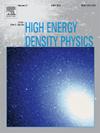Dark energy influenced compact spheres under Karmarkar condition
IF 0.9
3区 物理与天体物理
Q3 PHYSICS, FLUIDS & PLASMAS
引用次数: 0
Abstract
This paper investigates the viability and stability of anisotropic dark energy stars using the embedding class-1 technique within Einstein’s general relativity. The widely used Krori–Barua ansatz is adopted for the temporal metric component, while the radial counterpart is derived by enforcing the Karmarkar condition. To close the system, we introduce an equation of state in which the dark energy density is directly proportional to the isotropic baryonic fluid density, with the proportionality parameter . The model’s unknown parameters are determined by applying junction conditions between the interior solution and the Schwarzschild exterior manifold. A comprehensive physical analysis ensures the regularity and consistency of metric potentials and state determinants. The compactness factor and gravitational redshift provide insights into stellar objects such as PSR J1903+327, SMC X-4, LMC X-4 and Her X-1. Furthermore, energy bounds validate the model’s physical plausibility, while stability is examined through the Tolman–Oppenheimer–Volkoff equation, causality condition, Zeldovich criterion and adiabatic index. The results indicate that, for the observed masses and radii of the selected stellar objects, the proposed embedded model remains physically consistent, offering a viable and stable description of anisotropic dark energy stars.
暗能量对卡玛卡条件下致密球的影响
本文利用爱因斯坦广义相对论中的嵌入类-1技术研究了各向异性暗能量恒星的生存能力和稳定性。时间度量分量采用广泛使用的Krori-Barua ansatz,而径向分量则通过强制Karmarkar条件导出。为了关闭系统,我们引入了一个状态方程,其中暗能量密度与各向同性重子流体密度成正比,比例参数为ω。模型的未知参数通过应用内部解与Schwarzschild外部流形之间的连接条件来确定。全面的物理分析确保了度量势和状态决定因素的规律性和一致性。紧凑系数和引力红移提供了对PSR J1903+327、SMC X-4、LMC X-4和Her X-1等恒星天体的深入了解。此外,能量界验证了模型的物理合理性,同时通过Tolman-Oppenheimer-Volkoff方程、因果条件、Zeldovich判据和绝热指标检验了模型的稳定性。结果表明,对于所选恒星天体的观测质量和半径,所提出的嵌入模型在物理上保持一致,为各向异性暗能量恒星提供了一个可行的、稳定的描述。
本文章由计算机程序翻译,如有差异,请以英文原文为准。
求助全文
约1分钟内获得全文
求助全文
来源期刊

High Energy Density Physics
PHYSICS, FLUIDS & PLASMAS-
CiteScore
4.20
自引率
6.20%
发文量
13
审稿时长
6-12 weeks
期刊介绍:
High Energy Density Physics is an international journal covering original experimental and related theoretical work studying the physics of matter and radiation under extreme conditions. ''High energy density'' is understood to be an energy density exceeding about 1011 J/m3. The editors and the publisher are committed to provide this fast-growing community with a dedicated high quality channel to distribute their original findings.
Papers suitable for publication in this journal cover topics in both the warm and hot dense matter regimes, such as laboratory studies relevant to non-LTE kinetics at extreme conditions, planetary interiors, astrophysical phenomena, inertial fusion and includes studies of, for example, material properties and both stable and unstable hydrodynamics. Developments in associated theoretical areas, for example the modelling of strongly coupled, partially degenerate and relativistic plasmas, are also covered.
 求助内容:
求助内容: 应助结果提醒方式:
应助结果提醒方式:


